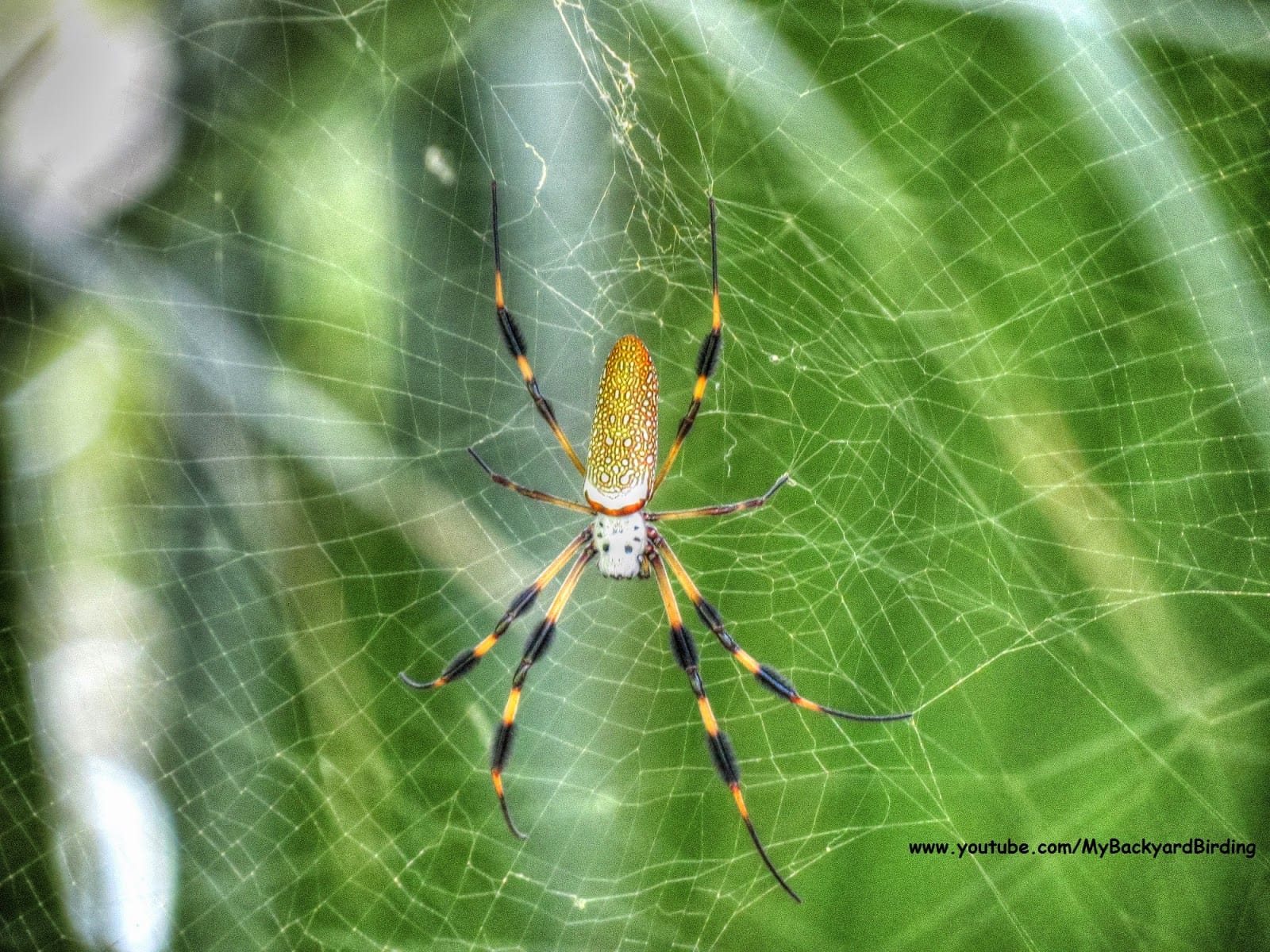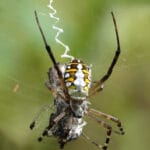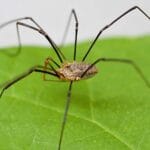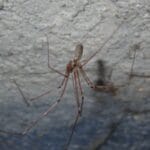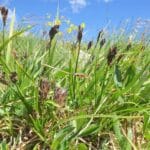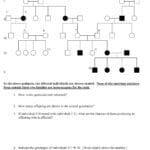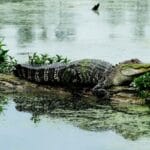Meet the golden silk spiders, nature’s master weavers! Their golden webs, sometimes as wide as your arms, are a sight to behold. They’re not just pretty, these webs are tough and help them catch all sorts of juicy meals. Let’s dive into the secrets of these amazing spiders, from their hunting skills to their family history and even their supersized cousins in Florida.
Golden Threads: The Art of the Golden Silk Spider
The golden silk spider (Trichonephila clavipes), a true artist of the natural world, captivates with its ability to spin webs that shimmer like gold. These aren’t your average, dusty spiderwebs; these intricate masterpieces have scientists incredibly excited about their potential uses, particularly in biomedicine.
One of the most striking things about these spiders is the dramatic size difference between males and females, a phenomenon known as sexual dimorphism. Females, the stars of the show, are significantly larger than their male counterparts, boasting a look that’s both elegant and bold. Imagine a silvery-white head atop a warm orange-brown abdomen dotted with white. Their legs, alternating between dark yellow and brown, complete the striking picture. Males, while essential for reproduction, are smaller and less colorful.
Their webs, often spanning two to three feet in diameter, are truly marvels of nature. These orb-shaped structures, often with a subtly uneven and asymmetrical appearance, dangle like giant, delicate doilies between branches, catching the sunlight with their shimmering gold threads. This golden hue comes from yellow pigments in the spider’s silk, which is not only beautiful but also incredibly strong.
The silk’s strength, rivaling that of steel, has captured the attention of scientists worldwide. Research suggests this incredible material could revolutionize fields from medicine to material science. Imagine: artificial tendons and ligaments, super-strong sutures for surgery—all thanks to the humble golden silk spider.
These fascinating creatures are most commonly found in the warmer regions of the Americas, particularly in the Antilles, Central America, and parts of the southern United States and Argentina. Favoring wooded areas and forests, their golden webs adorn trees and shrubs, creating a spectacle of nature’s artistry.
Like most spiders, the golden silk spider is a skilled hunter, patiently waiting for its prey—primarily small flying insects—to become ensnared in its intricate web. When it’s time to reproduce, the males engage in a delicate dance, carefully approaching the females on their webs to avoid becoming a meal themselves. It’s a risky business, but crucial for the survival of the species!
While the golden silk spider isn’t currently considered endangered, habitat loss is always a concern. Thankfully, ongoing research and conservation efforts are helping to protect these amazing creatures and their natural environments.
The golden silk spider is a shining example of how nature can inspire awe and innovation. Its silk, with its unique properties, has the potential to revolutionize various fields. By studying and appreciating these incredible spiders, we gain a deeper understanding of the natural world and unlock possibilities that could benefit humanity in countless ways.
Are Golden Silk Spiders a Threat? Separating Fact from Fiction
The sight of a golden silk spider, with its large size and intricate, glistening web, might make you wonder, “Is it dangerous?” It’s a fair question. After all, spiders have a bit of a reputation.
Rest assured, while golden silk spiders possess venom, it’s generally not a cause for concern for humans. Their venom is similar in potency to a bee sting. While a bite can cause pain, redness, and some swelling, it typically subsides without any lasting effects.
However, bites are rare. Golden silk spiders are shy creatures that would much rather retreat than bite. Their impressive webs, while marvels of engineering, are designed for catching insects, not humans.
In fact, these spiders play a vital role in maintaining a healthy ecosystem. As natural pest control agents, they feast on a variety of insects that might otherwise become nuisances.
Unfortunately, myths and misconceptions often surround these fascinating creatures. The term “banana spider,” sometimes used to refer to golden silk spiders, can lead to confusion with other spider species. Some people mistakenly believe they are highly venomous, which is simply not true.
The remarkable properties of their silk, particularly its incredible strength, are a testament to the wonders of the natural world. Scientists are actively exploring its potential applications in medicine and material science, opening up possibilities for new types of bandages and even super-strong materials. The future could be very bright, thanks in part to the humble golden silk spider.
Golden Silk Spider vs. Joro Spider: A Tale of Two Web Weavers
Golden silk spiders and Joro spiders, both masters of web construction, share the talent for weaving intricate, golden webs that shimmer in the sunlight. But while their webs may seem similar at first glance, these two spider species have distinct characteristics that set them apart.
Size is one key difference. Female golden silk spiders are significantly larger than their Joro counterparts, boasting a leg span of up to four inches. Joro spiders, while still impressive, are smaller, typically sporting a yellow or brown coloration.
Their webs, while both often adorned with a golden sheen, also have distinct features. Golden silk spiders craft large, multi-layered webs that lack a specific pattern. Joro spiders, on the other hand, incorporate a unique zig-zag pattern, known as a “stabilimentum,” into the center of their webs. The purpose of this intriguing feature remains a mystery, though some scientists believe it could play a role in attracting prey or deterring predators.
Their geographic distribution and social habits also differ. Golden silk spiders are native to the southeastern United States, while Joro spiders, originally from East Asia, are a relatively new addition to the US ecosystem, having spread rapidly along the East Coast. Golden silk spiders often live in colonies, with multiple females sharing a single web, while Joro spiders are generally more solitary.
So, while both spiders share a talent for weaving golden masterpieces, a closer look reveals key differences in their size, web structure, geographic distribution, and social behavior. The next time you encounter one of these eight-legged architects, take a moment to appreciate their unique characteristics and the wonders of the natural world they represent.
Golden Silk Spiders in Florida: How Big Do They Get?
Golden silk spiders, known for their impressive size, truly live up to their reputation in Florida. Female golden silk spiders, also known as golden silk orb-weavers or banana spiders, can reach a leg span of up to four inches—about the size of your palm! This makes them one of the largest non-tarantula spiders found in the Sunshine State. Males, as is typical for this species, are significantly smaller, usually only about an inch long.
These gentle giants are common throughout Florida, primarily inhabiting forests and wooded areas where they have ample space to construct their impressive webs. These webs, often stretching two to three feet in diameter, are not your typical dusty cobwebs; they are strong, intricate structures that shimmer with a beautiful golden hue, giving the spider its name. Positioned in sunny spots with plenty of insect traffic, these webs serve as effective traps for their unsuspecting prey.
Golden Silk Spider SEO Analysis
Recommended Titles:
To recommend titles, please provide the “collection of titles” you mentioned from your competitors.
Powerful Key Lines:
- Golden silk spiders weave webs of astonishing strength, rivaling even steel in toughness. (This highlights a fascinating and unique fact about the spider silk).
- Female golden silk spiders dwarf their male counterparts, showcasing a dramatic example of sexual dimorphism in nature. (This focuses on a visually striking characteristic and introduces a scientific concept.)
- From the tropics to your backyard, discover the captivating world of the golden silk spider. (This broadens the appeal to a wider audience and hints at the spider’s range).
- Scientists are unlocking the secrets of golden silk, exploring its potential applications in medicine and beyond. (This taps into the intrigue surrounding the spider silk’s properties and future possibilities.)
Important Details for Your Article:
1. Taxonomy and Naming:
- Scientific name: Trichonephila clavipes (formerly Nephila clavipes)
- Common names: Golden silk orb-weaver, golden silk spider, golden orb weaver spider, banana spider (shared with other species)
- Family: Araneidae (orb-weavers) – Note: The classification as Nephilidae is debated.
2. Physical Characteristics:
- Sexual dimorphism: Females are significantly larger than males.
- Females: 24-40 mm in length, possibly the largest orb-weavers in the US
- Males: Much smaller, less distinctive coloring
- Coloration:
- Females: Silvery white cephalothorax, orange-brown abdomen with two rows of small white-yellow spots. Abdomen color changes with maturity. Legs are dark yellow and brown.
- Webs: Large, vertical, asymmetric, and orb-shaped. Known for their golden color due to yellow pigment in the silk.
3. Distribution and Habitat:
- Primarily found in: Antilles and Central America (Mexico to Panama)
- Less abundantly in: Southern US states (south), Argentina (south)
- Habitat: Forests and wooded areas
4. Diet and Web Use:
- Prey: Small flying insects (grasshoppers, flies, etc.)
- Web Function: Primarily for trapping flying prey
5. Reproduction and Life Cycle:
- Mating: Males search for females on their webs.
- Silk Glands: Possess seven different types of silk glands, each producing silk for different purposes (webs, egg sacs, wrapping prey).
6. Golden Silk Properties and Uses:
- Strength: Exceptionally strong, comparable to steel in toughness.
- Color: Distinctive golden yellow due to carotenoids in the silk.
- Potential Applications: Biomedical research (tissue engineering, wound healing), textile industry (high-performance fabrics).
Structured Context:
I. Introduction:
* Start with a captivating hook about the golden silk spider’s unique features (e.g., web strength, size, color).
* Briefly introduce the spider’s taxonomy and common names.
II. Appearance and Sexual Dimorphism:
* Describe the striking size difference between males and females.
* Detail the female’s distinctive coloration, highlighting the changes with maturity.
* Briefly mention the less conspicuous male.
III. Web Wonders:
* Focus on the impressive size and structure of the webs.
* Explain the golden color and its origin (carotenoids).
* Discuss the web’s effectiveness in trapping prey.
IV. Habitat and Range:
* Map out their primary and less common distribution areas.
* Describe their preferred habitats.
V. Life Cycle and Reproduction:
* Briefly explain the mating behavior.
* Mention the different silk types produced and their purposes.
VI. The Power of Golden Silk:
* Highlight the exceptional strength and toughness of the silk.
* Discuss current and potential applications in various fields.
VII. Conservation and Human Interaction:
* Address if there are any conservation concerns.
* Mention if they pose any threat to humans (generally not considered dangerous).
Unique Insights and Untapped Potential:
- Focus on the cutting-edge research: Dive deeper into the specific biomedical and engineering applications of golden silk. Explore the latest studies and potential breakthroughs.
- Compare and contrast golden silk to other spider silks: Analyze the unique properties of golden silk compared to other spider species. This adds a comparative element and positions golden silk within a broader scientific context.
- Highlight the conservation angle: While not currently endangered, discuss the potential impact of habitat loss on golden silk spiders. Promote responsible interactions with these fascinating creatures.
- Weave in captivating visuals: Include high-quality images and videos showcasing the spider’s beauty, web construction, and the silk’s golden sheen.
By incorporating these elements and maintaining a clear, engaging writing style, you’ll create a comprehensive and compelling SEO article that surpasses your competitors.
Key Points:
- Golden silk spiders have a mild venom comparable to a bee sting.
- They are generally non-aggressive and avoid human interaction.
- Their webs are designed for capturing prey, not defense.
- Golden silk spiders play a significant ecological role by controlling insect populations.
- Their silk possesses exceptional strength and potential applications in medicine and material science.
- The “banana spider” term can lead to confusion, as golden silk spiders are not highly venomous.
Key Differences between Golden Silk Spiders and Joro Spiders:
- Size and Appearance:
- Golden silk spiders are larger with hairy legs.
- Joro spiders are smaller with smooth legs.
- Web Structure:
- Golden silk spiders build large, multi-layered webs without a zig-zag pattern.
- Joro spiders build golden webs with a distinctive zig-zag pattern (stabilimentum).
- Distribution:
- Golden silk spiders are native to the southeastern US.
- Joro spiders are an invasive species introduced from East Asia.
- Behavior:
- Golden silk spiders often live in colonies.
- Joro spiders are more solitary.
Key Points:
- Females of golden silk spiders in Florida can reach 4 inches in length, making them one of the largest non-tarantula spiders in the state.
- Males are significantly smaller, at around 1 inch in length.
- The large size difference is a distinctive feature of the species.
- These spiders are common throughout Florida, preferring forests and wooded areas.
- Their golden-colored webs are large, measuring 2-3 feet in diameter.
Internal Links:
- Ever heard of a hairless cat? No, we don’t mean a cat without hair. We meant the hairless cat tattoo! Delve into the unique world of hairless cat tattoos by reading this article. hairless cat tattoo
- The story of Ham the chimp, the first chimpanzee to ever be launched into space, has fascinated space enthusiasts for decades. ham the chimp
- Crypto Quotes’ Red Flags: Avoid Costly Mistakes - June 30, 2025
- Unlock Inspirational Crypto Quotes: Future Predictions - June 30, 2025
- Famous Bitcoin Quotes: A Deep Dive into Crypto’s History - June 30, 2025
